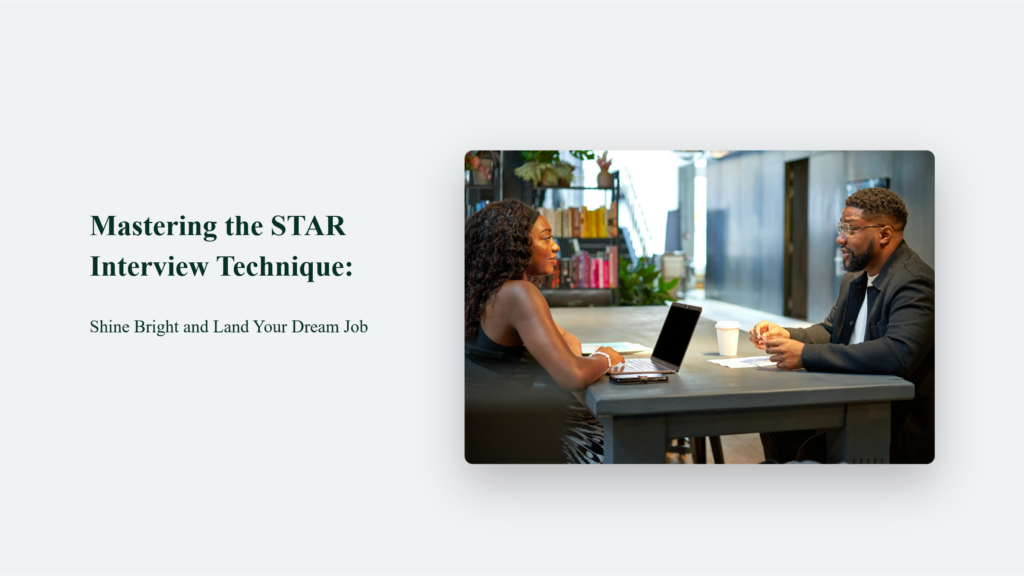

Mastering the STAR Interview Technique: Shine Bright and Land Your Dream Job

As Seen On
Have you ever found yourself at a loss for words during a job interview? You’re not alone. Many job seekers need help to articulate their experiences and qualifications effectively. But fear not! The STAR interview technique is here to save the day. In this article, I’ll guide you through the ins and outs of this powerful method, helping you shine bright like a star and land your dream job.

What is the STAR Interview Technique?
The STAR interview technique is a structured approach to answering behavioural interview questions. It’s designed to help you provide concrete examples of your skills and experiences, making you stand out from the competition. STAR stands for:
- Situation: Describe a specific situation or challenge you faced.
- Task: Explain the task or goal you were working towards.
- Action: Detail your actions to address the situation or achieve the goal.
- Result: Share the outcomes of your actions and the lessons you learned.
Following this format, you can deliver clear, concise, and compelling answers that showcase your abilities and leave a lasting impression on the interviewer.
Why Use the STAR Interview Technique?
In today’s competitive job market, more than listing your skills and experiences on your resume is required. Employers want to know how you’ve applied those skills in real-world situations. The STAR interview technique allows you to:
- Demonstrate your problem-solving abilities
- Highlight your leadership and teamwork skills
- Show your ability to learn from challenges and failures
- Provide specific, measurable results that prove your value
Using the STAR method, you can vividly picture your accomplishments and make a strong case for why you’re the best candidate for the job.
How to Prepare for a STAR Interview
To excel in a STAR interview, preparation is key. Here’s a step-by-step guide to help you get ready:
- Review the job description: Identify the key skills and qualifications the employer seeks.
- Brainstorm relevant experiences: Consider when you’ve demonstrated those skills in your work, education, or volunteer activities.
- Write out your STAR stories: For each experience, jot down the situation, task, action, and result. Be specific and quantify your results whenever possible.
- Practice, practice, practice: Rehearse your STAR stories out loud until you can deliver them smoothly and confidently. Ask a friend or family member to role-play as the interviewer and give you feedback.
By taking the time to prepare, you’ll feel more confident and composed during the actual interview.
Example STAR Interview Questions and Answers:
To help you grasp the STAR technique, let’s look at a few common behavioural interview questions and sample answers:
Question 1: Tell me about a time when you had to manage a challenging project.
Situation: As a marketing coordinator, I was tasked with launching a new product campaign on a tight deadline and limited budget.
Task: My goal was to create a comprehensive marketing strategy to generate buzz and drive sales within the first month of the product launch.
Action: I assembled a cross-functional team of designers, copywriters, and social media specialists. We brainstormed creative ideas, prioritized our tactics based on impact and feasibility, and developed a detailed project plan. I managed the team’s progress, communicated regularly with stakeholders, and made adjustments to stay on track.
Result: Thanks to our collaborative efforts and strategic planning, we launched the campaign on time and within budget. The product exceeded sales targets by 20% in the first month, and our campaign received positive feedback from customers and industry partners alike. I learned the importance of clear communication, adaptability, and leveraging diverse skill sets to achieve a common goal.
Question 2: Describe a situation where you had to persuade someone to see things your way.
Situation: As a customer service representative, I once dealt with a highly dissatisfied customer who demanded a full refund for a product they had misused.
Task: My objective was to find a solution to address the customer’s concerns while upholding our company’s policies and protecting our bottom line.
Action: I actively listened to the customer’s frustrations and empathized with their situation. I calmly explained our refund policy and the reasons behind it. Then, I offered an alternative solution – a partial refund and a complimentary product demonstration to help them use the item correctly.
Result: By validating the customer’s feelings and finding a fair compromise, I could de-escalate the situation and reach a mutually beneficial outcome. The customer accepted the partial refund and left a positive review about their experience. This incident taught me the power of active listening, empathy, and creative problem-solving in customer service.
Tips for Acing Your STAR Interview
Now that you understand the basics of the STAR technique, here are some additional tips to help you shine:
- Be concise: Aim for 1-2 minute answers that get straight to the point. Avoid rambling or getting lost in unnecessary details.
- Use “I” statements: Focus on your specific actions and contributions rather than generalizing about your team or company.
- Be honest: Don’t embellish or fabricate your experiences. Authenticity is key to building trust with the interviewer.
- Show enthusiasm: Let your passion for your work and achievements shine through in your answers. Smile, maintain eye contact, and use engaging body language.
- Prepare for follow-up questions: The interviewer may ask for more details or probe deeper into your experiences. Be ready to elaborate on your STAR stories if needed.
By following these tips and practising the STAR technique, you’ll be well-equipped to handle any behavioural interview question that comes your way.
Conclusion:
The STAR interview technique is a powerful tool for showcasing your skills, experiences, and achievements clearly and compellingly. By mastering this method, you’ll stand out from the competition and increase your chances of landing your dream job.
Interview success is not about memorizing scripts or trying to be someone you’re not. It’s about authentically conveying your unique value proposition and connecting with the interviewer on a human level.
So go forth and let your STAR qualities shine! With preparation, practice, and confidence, you’ll be well on your way to acing your next interview and taking your career to new heights.
Frequently Asked Questions:
Can I use the STAR technique for other types of interview questions?
While the STAR method is primarily used for behavioral questions, you can adapt it for other types of questions as well. For example, you can use the STAR format to describe your relevant skills or experiences in response to a technical or situational question.
What if I can’t think of a specific example for a STAR question?
If you’re struggling to come up with a relevant example on the spot, it’s okay to take a moment to think. You can also ask the interviewer to clarify the question or provide more context. If you truly can’t think of an example, be honest and offer to share a related experience or skill instead.
Gracie Jones
Up until working with Casey, we had only had poor to mediocre experiences outsourcing work to agencies. Casey & the team at CJ&CO are the exception to the rule.
Communication was beyond great, his understanding of our vision was phenomenal, and instead of needing babysitting like the other agencies we worked with, he was not only completely dependable but also gave us sound suggestions on how to get better results, at the risk of us not needing him for the initial job we requested (absolute gem).
This has truly been the first time we worked with someone outside of our business that quickly grasped our vision, and that I could completely forget about and would still deliver above expectations.
I honestly can’t wait to work in many more projects together!
Disclaimer
*The information this blog provides is for general informational purposes only and is not intended as financial or professional advice. The information may not reflect current developments and may be changed or updated without notice. Any opinions expressed on this blog are the author’s own and do not necessarily reflect the views of the author’s employer or any other organization. You should not act or rely on any information contained in this blog without first seeking the advice of a professional. No representation or warranty, express or implied, is made as to the accuracy or completeness of the information contained in this blog. The author and affiliated parties assume no liability for any errors or omissions.

